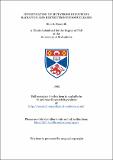Files in this item
Investigation of mutations induced by radiation and restriction endonucleases
Item metadata
| dc.contributor.advisor | Bryant, Peter Edward | |
| dc.contributor.author | Haworth, Kim E. | |
| dc.coverage.spatial | 155 p., 4 p. of plates. | en_US |
| dc.date.accessioned | 2018-06-20T11:01:58Z | |
| dc.date.available | 2018-06-20T11:01:58Z | |
| dc.date.issued | 1995 | |
| dc.identifier.uri | https://hdl.handle.net/10023/14327 | |
| dc.description.abstract | The effects of gamma radiation and restriction endonuclease (RE) induced DNA double strand breaks (dsb) upon the mutation frequency and the surviving fraction of three Chinese hamster cell lines V79-4, CHO-K1 and an X-ray sensitive dsb repair deficient cell line xrs-5 were studied. The X-ray sensitive xrs-5 cell line was shown to be more sensitive to both the lethal and the mutagenic effects of gamma radiation having a substantially lower surviving fraction and a higher thymidine kinase (tk) mutation frequency per unit dose than the parental CHO-K1 cells. The frequency of induced hprt- mutations in the V79-4 cell line was comparable to the induced frequency of tk mutations in the CHO-K1 cells. The effect of blunt- and cohesive- ended dsb upon the surviving fraction and the induced mutation frequency was studied by porating different Chinese hamster cell lines (CHO-K1, V79-4 and xrs-5) with RE using Streptolysin O (SLO). The surviving fraction of the different cell lines was reduced with increasing concentrations of Pvu II. Increases in the concentration of Pvu II produced increases in the frequency of hypoxyanthine guanine phosphoribosyl transferase (hprt) mutations in the V79-4 cells and tk mutations in the CHO-K1 and xrs-5 cells. However, the xrs-5 cells were shown to be hypomutable to Pvu II compared with the parental CHO-K1 cells. EcoR1 was ineffective at inducing tk mutations in the CHO-Kl cells but was as effective as Pvu II at inducing hprt mutations in the V79-4 cells. None of the spontaneously induced V79-4 hprt- mutant cells were shown to have observable molecular deletions when analysed by PCR deletion screening. One third of the radiation induced hprt - mutants were shown to be deletions. However, too few mutant cells were analysed for any non-random distribution of deletions to be observed. Half of the hprt- mutants induced by SLO poration alone were shown to be due to deletions of oi\e or more exons. The distribution of the DNA deletions in SLO hprt- mutations appeared to be nonrandom. The PCR amplification products of exons 7&8 were more frequently lost than any of the other exons in the hprt gene. It has been suggested that the SLO provided by the manufacturer used to porate the cells was contaminated with small amounts of endonucleases and exonucleases. The Pvu II induced deletions also appeared to be non-randomly distributed. The PCR amplification products of exon 2 were more frequently absent than any of the other exon products. Sequence data from the EMBL library indicated that Pvu II had a restriction site adjacent to the exon 2 nucleotide sequence of the Chinese hamster hprt gene but not in or bordering the other exons. This provides evidence that the blunt-ended dsb plays a role in the production of mutations. Mutation studies indicated that there is only one active copy of the autosomally located thymidine kinase gene in the CHO-K1 cells and their daughter cell lines (Singh and Bryant, 1991). However, whether the other homologous copy has been inactivated or deleted is not known. Experiments attempting to locate the thymidine kinase gene(s) were performed using FISH and a mouse tk cDNA probe. However, these attempts were unsuccessful. | en_US |
| dc.language.iso | en | en_US |
| dc.publisher | University of St Andrews | |
| dc.subject.lcc | QP609.N8H2 | |
| dc.subject.lcsh | Phosphatases | en |
| dc.title | Investigation of mutations induced by radiation and restriction endonucleases | en_US |
| dc.type | Thesis | en_US |
| dc.contributor.sponsor | British Nuclear Fuels (BNFL) | en_US |
| dc.type.qualificationlevel | Doctoral | en_US |
| dc.type.qualificationname | PhD Doctor of Philosophy | en_US |
| dc.publisher.institution | The University of St Andrews | en_US |
This item appears in the following Collection(s)
Items in the St Andrews Research Repository are protected by copyright, with all rights reserved, unless otherwise indicated.

